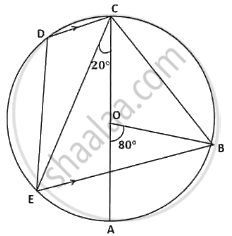Advertisements
Advertisements
Question
In the figure, ∠DBC = 58°. BD is diameter of the circle.
Calculate:
- ∠BDC
- ∠BEC
- ∠BAC
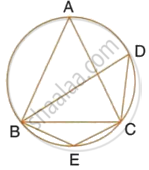
Solution
∠DBC = 58° ...(Given)
Now, BD is the diameter.
∴ ∠DCB = 90° ...(Angle in a semicircle)
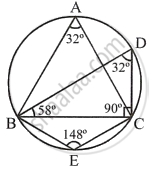
i. In ΔBDC,
∠BDC + 90° + 58° = 180° ...(Sum of the angles of a triangle)
∴ ∠BDC = 180° – (90° + 58°) = 32°
ii. BECD is a cyclic quadrilateral.
∵ ∠BEC + ∠BDC = 180° ...(Opposite angles of a cyclic quadrilateral)
∴ ∠BEC = 180° – ∠BDC
∴ ∠BEC = 180° – 32° = 148°
iii. ∠BAC = ∠BDC = 32° ...(Angles in the same segment of a circle)
APPEARS IN
RELATED QUESTIONS
Prove that the parallelogram, inscribed in a circle, is a rectangle.
Prove that the rhombus, inscribed in a circle, is a square.
In the given figure, RS is a diameter of the circle. NM is parallel to RS and ∠MRS = 29°. Calculate : ∠RNM
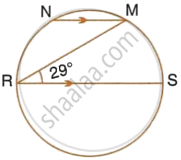
ABCD is a cyclic quadrilateral in which AB is parallel to DC and AB is a diameter of the circle. Given ∠BED = 65°; calculate :
- ∠DAB,
- ∠BDC.

In the given figure, PQ is a diameter. Chord SR is parallel to PQ. Given that ∠PQR = 58°,
Calculate:
- ∠RPQ,
- ∠STP.
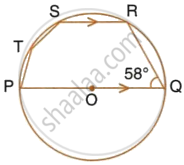
In the following figure, AD is the diameter of the circle with centre O. Chords AB, BC and CD are equal. If ∠DEF = 110°, calculate: ∠AEF
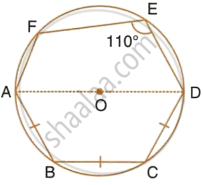
Using ruler and a compass only construct a semi-circle with diameter BC = 7cm. Locate a point A on the circumference of the semicircle such that A is equidistant from B and C. Complete the cyclic quadrilateral ABCD, such that D is equidistant from AB and BC. Measure ∠ADC and write it down.
In the given figure, AB is a diameter of the circle with centre O. DO is parallel to CB and ∠DCB = 120°.
Calculate : ∠DBC
Also, show that the ΔAOD is an equilateral triangle.

In the given figure AC is the diameter of the circle with centre O. CD is parallel to BE.
∠AOB = 80° and ∠ACE = 20°.
Calculate
- ∠BEC
- ∠BCD
- ∠CED
